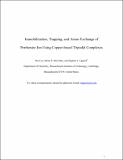Immobilization, Trapping, and Anion Exchange of Perrhenate Ion Using Copper-Based Tripodal Complexes
Author(s)
Cao, Rui; McCarthy, Brian D.; Lippard, Stephen J.
DownloadFinalRev.Ms.pdf (2.497Mb)
OPEN_ACCESS_POLICY
Open Access Policy
Creative Commons Attribution-Noncommercial-Share Alike
Terms of use
Metadata
Show full item recordAbstract
We describe a multidentate tripodal ligand in which three pendant arms carrying di(2-picolyl)amine units are linked to the ortho positions of a tris(o-xylyl) scaffold, providing N(CH[subscript 2]-o-C[subscript 6]H[subscript 4]CH[subscript 2]N(CH2py)[subscript 2])[subscript 3] (L). Reaction of L with CuCl[subscript 2] in the presence of hexafluorophosphate anion afforded blue cubes of [(CuCl)[subscript 3]L](PF[subscript 6])[subscript 3]·5H[subscript 2]O (1). Crystallographic studies of 1 revealed that the three symmetry-related arms each coordinate a {Cu[superscript II]Cl} unit, and two molecules of 1 are connected to one another through a Cu(μ-Cl)[subscript 2]Cu bridge, extending the molecular structure to form a two-dimensional (2-D) layer. These 2-D layers pack in an ABCABC... fashion with PF[subscript 6]– anions located in between. Reaction of 1 with a stoichiometric amount of perrhenate ion afforded blue plates of [(CuCl)[subscript 3]L](PF[subscript 6])(ReO[subscript 4])[subscript 2]·3H[subscript 2]O (2). Compound 2 has the same lattice structure as 1, but the tricopper unit backbone now traps one ReO[subscript 4]– anion through Coulombic interactions. In addition, three molecules of 2 are bridged by a perrhenate ion, forming a Cu[subscript 3](μ[superscript 3]-ReO[subscript 4]) cluster, to give a different 2-D structure displaying a rare tridentate bridging ReO[subscript 4]– mode. Thus, in addition to classic perrhenate trapping through weak Coulombic interactions, 2 represents an exceptional example in which the ReO[subscript 4]– anion is immobilized in an extended framework through tight covalent interactions. The interlamellar PF[subscript 6]– anions in 1 can be exchanged with other anions including perrhenate, perchlorate, or periodate. The structural similarity between perrhenate and pertechnetate makes these materials of potential interest for pertechnetate trapping.
Date issued
2011-08Department
Massachusetts Institute of Technology. Department of ChemistryJournal
Inorganic Chemistry
Publisher
American Chemical Society (ACS)
Citation
Cao, Rui, Brian D. McCarthy, and Stephen J. Lippard. “Immobilization, Trapping, and Anion Exchange of Perrhenate Ion Using Copper-Based Tripodal Complexes.” Inorganic Chemistry 50.19 (2011): 9499–9507.
Version: Author's final manuscript
ISSN
0020-1669
1520-510X